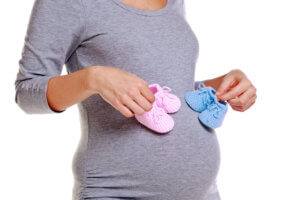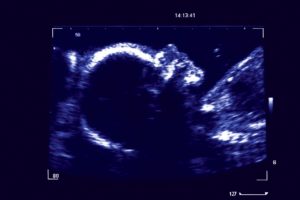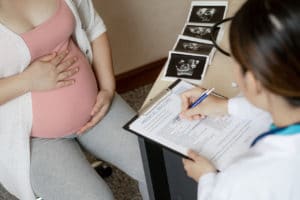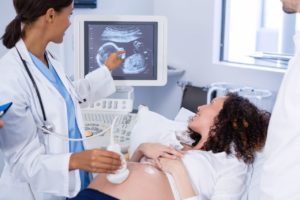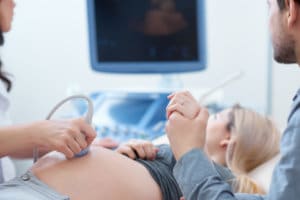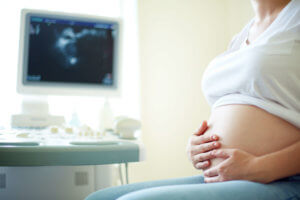The amniotic fluid test strip is an important tool for expectant mothers who, for various reasons or to be on the safe side, would like to perform an amniocentesis “on their own”. An amniotic fluid test strip is a urine test strip made of litmus paper that changes color under certain conditions. The degree of discoloration can be used to generate relevant findings based on the quality of the amniotic fluid.
Table of contents
An Amniotic Fluid Test Strip – The Informative Urine Test Strip
The amniocentesis that your gynecologist performs when necessary is called amniocentesis. With the help of amniocentesis, it is possible to determine any hereditary diseases as well as deviations in the genetic material of the unborn baby. Even malformations, infections, etc. can be detected with amniocentesis. Although amniocentesis is quite complex, it gives expectant moms and dads a great deal of security.
Amniocentesis In The Gynecological Practice
Compared to the use of amniocentesis test strips, the amniocentesis performed by a gynecologist is very complex. In this procedure, the physician removes a small amount of amniotic fluid from the amniotic sac with the help of a hollow needle. This contains fetal cells that can be isolated and then multiplied in cell culture. Such a cell culture is important because only then is sufficient genetic material available to perform the necessary medical examinations.
This article tells you when amniocentesis is necessary and how to use the amniocentesis test strip correctly at home.
This Is Why Amniotic Fluid Test Strips Are Indispensable In Certain Situations
The amniotic sac contains amniotic fluid. However, this will not have the same quality or consistency in the course of pregnancy. Rather, the amniotic fluid is subject to a natural cycle, which ensures that a complete exchange takes place at intervals of about two to three hours. This means that the production and absorption of the fluid should always remain in balance during pregnancy. To ensure this, amniocentesis can be helpful.
Good To Know
The baby drinks the amniotic fluid and thus absorbs the nutrients it contains. The fluid is absorbed through the intestines. Later, it enters the mother’s bloodstream via the placenta. There, the amniotic fluid is excreted again via the kidneys. The cycle starts all over again.
The Amniocentesis
Within the scope of amniocentesis, it is possible, on the one hand, to detect diseases or hereditary changes. On the other hand, amniocentesis makes it possible to determine the concentrations of two relevant proteins in the amniotic fluid. These are the alpha-fetoprotein (AFP) and the acetylcholinesterase enzyme (AChE). If one or both of these values are elevated, this usually indicates a malformation of the abdominal wall or spinal column.
How Is It Possible To Obtain Meaningful Results?
Alpha-fetoprotein is produced in the liver as well as in the yolk sac of the unborn child. If the embryo is healthy, only a very small amount of the AFP protein will enter the amniotic fluid through its urine. In the case of an open back or other so-called neural tube defects, AFP levels are sometimes drastically elevated. This is because larger amounts of it are released into the amniotic fluid via the cerebrospinal fluid.
With the help of the amniotic fluid examination, it is also possible to determine the risk of Down syndrome or trisomy 21. The AChE protein is an enzyme of the nervous system. If a neural tube defect is present in the unborn baby, the AChE level is also significantly elevated.
These Diseases Can Be Detected By The Examination Already During Pregnancy
– The nature of the DNA or genetic material.
– Number of chromosomes and their structure.
– Genetic abnormalities such as Down syndrome.
– Trisomy 18 or Edwards syndrome.
– Trisomy 13 or the Pätau syndrome.
– Metabolic disorders.
– Abdominal wall defects.
– Open back or spina bifida.
– Toxoplasmosis.
– Possible blood group incompatibility between mother and child (this can only be determined from the 30th week of pregnancy).
– Condition of the lungs.
Notice
Under certain conditions, gynecologists advise expectant mothers to have an amniotic fluid test. The most important reasons for amniocentesis are:
– The pregnant woman is older than 35 years of age.
– Abnormalities in the so-called first-semester screening.
– Abnormalities in previous ultrasound examinations.
– If the urine is cloudy.
– If familial hereditary diseases are present.
– If there are muscular or metabolic diseases on the mother’s or father’s side.
– If there is already a sibling with a chromosomal defect.
– Previous premature births or miscarriages.
Good To Know:
If one of the aforementioned indications exists that requires an amniocentesis, health insurance companies usually cover the costs incurred.
An amniocentesis is usually performed between the 14th and 19th week of pregnancy. If amniocentesis were performed at an earlier time, the physician would not be able to generate accurate findings. In addition, early amniocentesis could trigger a miscarriage.
Here’s How Amniocentesis Proceeds:
If the amniotic fluid needs to be examined, the gynecologist first conducts a detailed consultation. The examination that follows is usually performed on an outpatient basis. It is important that the procedure is performed in an appropriately specialized practice or clinic.
– Before the examination can even be performed, an examination of the child’s position in the womb is carried out using the latest ultrasound technologies. At the same time, the specialist marks the intended puncture site on the abdomen.
– The marked site is carefully disinfected. After that, the doctor pierces the abdominal wall and the uterine wall with a very fine needle until he reaches the amniotic sac.
– In the next step, he punctures the amniotic sac and draws up about 15 to 20 ml of amniotic fluid.
– The hollow needle is withdrawn again and the generated fluid and the cells it contains are processed in the laboratory.
Good To Know
The duration of an amniotic fluid examination generally takes about five to 15 minutes. Although most women do not find the procedure painful, other expectant mothers complain of sometimes considerable pressure. In most cases, local anesthesia is not used.
– Even after the amniotic fluid has been examined, many pregnant women notice a certain feeling of pressure in their abdomen. However, this will subside a few minutes after the procedure.
Notice
You may leave the practice or clinic on the same day. However, your doctor will certainly recommend bed rest for about two to three days. In addition, avoid strenuous physical activities and sexual intercourse if possible. After the rest period, you will have a follow-up check-up with your gynecologist, and about two to three weeks later you will find out the results of the examination.
By The Way
In case of severe pain in the abdomen or in the abdominal region, or if there is bleeding, you should immediately consult a gynecologist.
Today, an examination of the amniotic fluid is already considered a routine procedure. Nevertheless, complications can occur under certain circumstances. In rare cases, a miscarriage or premature rupture of the membranes may occur. Contractions of the uterus, bleeding, or injuries to the unborn baby are possible if necessary. However, the number of corresponding cases is vanishingly small.
What If The Test Is Positive?
Naturally, expectant parents hope that the results of the examination of the amniotic fluid will be negative. In case of a positive result, it is sometimes necessary to terminate the pregnancy. However, before taking such a step, the pregnant woman concerned is given detailed and very intensive counseling.
Because an examination of the amniotic fluid can only be performed at a relatively late stage of pregnancy, it is no longer possible to perform suction or curettage in the event of a positive examination. This means that an artificial miscarriage must be induced. Labor-promoting preparations are used in this case. For the pregnant woman, such a measure is extremely stressful both emotionally and physically and can be associated with serious psychological consequences. It is therefore often advisable to seek psychological or psychotherapeutic treatment.
Performing Amniocentesis “On Your Own” With A Urine Test Strip
When the amniotic sac breaks, this is called rupture of the membranes in specialist circles. Ideally, this happens shortly before birth. However, in high-risk or multiple pregnancies, as well as for other reasons, it is conceivable that a rupture of the membranes occurs much earlier. Once the water has broken, a little fluid usually goes out. Many women think that this is urine fluid.
If The Urine Is Cloudy
Because amniotic fluid visually resembles urine fluid, it is usually difficult to determine in layman’s terms whether the amniotic sac has broken or whether the urine has been discharged. The latter is not uncommon due to the increasing weakness of the pelvic floor muscles of pregnant women. You can use an amniotic fluid test strip to check for yourself at home whether your water has broken or whether it is urine. If the urine is cloudy, there is an increased risk of confusion with the fluid from the amniotic sac.
The amniotic fluid test strip determines the so-called IGF1 value. This is a fetal protein value that can be determined by using normal litmus paper. If the amniotic fluid test strip shows a positive change, this is an indication that amniotic fluid must have leaked out. Consequently, the amniotic sac has broken or at least ruptured to some extent. Depending on the result of the amniotic fluid test strip, an immediate visit to your trusted gynecologist is essential. Because now the birth of your child may be imminent.
Tips
Amniotic fluid test strips are available in every well-stocked pharmacy. It is best to get the amniotic fluid test strip several weeks before the expected date of birth. This way, you have the amniotic fluid test strip at hand “just in case” and can be on the safe side.
However, you should bear in mind that the results provided by an amniotic fluid test strip are not always 100 percent reliable. This is because the amount of fluid is sometimes not sufficient to make a really reliable diagnosis. Therefore, if in doubt, visit your gynecologist immediately and have yourself examined accordingly. Alternatively, you can ask your midwife for advice.
Conclusion
An examination of the amniotic fluid is of elementary importance under certain circumstances. At the same time, however, you should bear in mind that amniocentesis is no guarantee of a healthy baby. Generally, amniocentesis is recommended for pregnant women who are over the age of 35. In addition, there are other aspects that make amniocentesis unavoidable. With a urine test strip or an amniotic fluid test strip, you can find out for yourself at home whether your water has broken. Urine that is cloudy cannot always be distinguished from amniotic fluid.

